#Animalia Almanac
Text
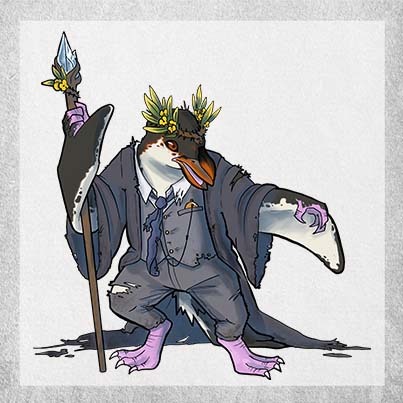

This months subspecies sheet is out! (already? I know!)
This species is known for their amazing cooking skills and golden crown of feathers. Every year a large cooking competition is held on the Schlegeli home island of Macquarie where the most amazing dishes are made. There are prizes for the most tasty dish, but also prize for those that can make a tasty dish with some of the most disgusting tasting ingredients. This is done in the spirit of the Schlegeli legend where their ancestors had to eat the horrible tasting crown of thorns plant to survive.
full subspecies sheet and legend can be found here
the amazing artist for this subspecies legend is
24 notes
·
View notes
Text

penguins :o this is actually fanart!
check out Yeesha's @yeeshastone ttrpg Animalia Almanac at animaliaalmanac.com
best wishes, Dew
15 notes
·
View notes
Text
Let’s KRILL this love!
Did you know that Antarctic Krill can glow in the dark (like a lightstick *0*)?

They are bioluminescent! That means krill swarms look like a KPOP ocean!

Classification
Kingdom: Animalia
Subkingdom: Bilateria
Infrakingdom: Protostomia
Superphylum: Ecdysozoa
Phylum: Arthropoda
Class: Malacostraca
Subclass: Eumalacostraca
Order: Euphausiacea
Family: Euphausiidae
Genus: Euphausia
Species: Euphausia superba
(ITIS, n.d.)
Distribution and habitat
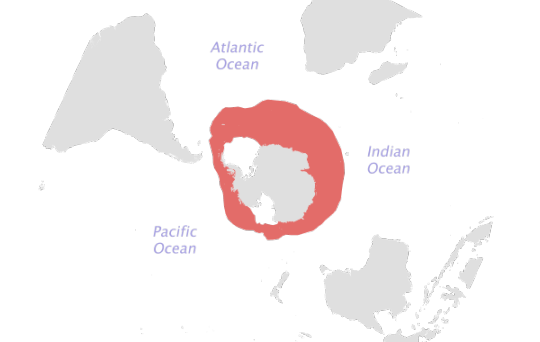
Figure 1. Geographical Distribution of Antarctic krill (fao.org, n,d,)
E. superba inhabits a wide circumpolar belt between the Antarctic Continental Shelf break and the Antarctic Polar Frontal Zone. Antarctic krill live in open marine waters (fao.org, n.d.). The larvae of the krill begin near the seafloor and gradually ascend towards the surface as it develops. Adult krills are found at depths ranging from surface waters to depths of 350 m and have occasionally been found as deep as 600 m. They usually dwell in deeper waters during the winter season (Gierak, n.d.).
Anatomy

Figure 2. External Anatomy of Antarctic Krill
E. superba known as Antarctic krills are shrimp-like in appearance though they can easily be distinguished from shrimp by their visible gills. Just like any other decapods they have exoskeleton which are made of chitin and have three body parts which is the cephalothorax, pleon and the telson. The cephalothorax bears the antennae, compound eye, 6 filter legs which are also called thoracopods and the gills. Krills have compound eyes which aid them in seeing while their antennae serve as another sensory organ as they live in the deep. The thoracopods or the filter legs on the other hand, assists the krill in straining its food from the water. Although the gills, guts and gastric mill are not part of its external anatomy, the three are visible from the outside. The middle part of its body is the pleon where the pleopods and the photophores are located. There are 5 pairs of pleopods or swimming legs that allow them to swim in the water column while the photophores or light organs act as a defense mechanism or a signal for their mates. Lastly, is the telson which is used by decapods as a paddle in caridoid escape reactions through backward propulsion (Grzimek's Student Animal Life Resource, n.d.).
Life Cycle
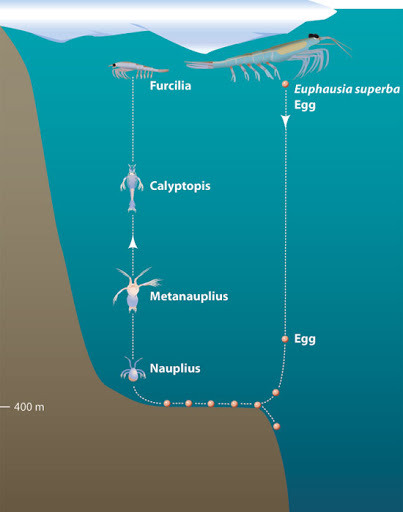
Figure 3. Life Cycle of an Antarctic Krills
Krills reproduce sexually and it usually happens when food is abundant. The male krill produces sperm packets and uses its first pair of pleopods called petasma to transfer the sperm into the thelycum of the female. They store the sperm until they are ready to lay their eggs. These eggs are fertilized once they are released by the female. These eggs settle at the seafloor and gastrulation happens. Eventually, the eggs will hatch and become a nauplius. In this the nauplius has only one eye and is not segmented yet. Then, the nauplius will molt and become a metanauplius wherein limb development begins and it will start to migrate to the surface which is known as developmental ascent. As it molts and grows, it becomes a calyptopis and eventually a furcilia wherein the movable compound eyes start to project at the edge of its carapace. The furcilia develops into a juvenile which can grow from 4 to 10 mm long (Gierak, 2013).
Ecology

Figure 4. Thoracic endopodite of krill (wikipedia.org, n.d.)
Antarctic krill are filter-feeders that feed mainly on phytoplankton. They exhibit diurnal vertical migration, which means that they rise to the surface at night to feed by using their small, hair-like legs specifically thoracic endopodites as a suspension feeding basket. Apart from phytoplankton, they also eat copepods, zooplankton, and other krill or molted exoskeletons. In the winter, they eat algae under the surface of sea ice. They are considered the dominant herbivore of the Southern Ocean. Its biomass in the Antarctic Ocean is estimated to be between 125 mmt and 750 mmt, the largest biomass of any species on earth (Hardy, 2008). Antarctic krill is the keystone species of the entire Antarctic food chain. They provide a vital food source for whales, seals, squids, penguins, fishes, albatrosses, and many other species of birds. To avoid predation, they exhibit schooling behavior or swarming. Moreover, krill may be parasitized by organisms like protozoans, particularly the genus Ephelota. This suctorian ciliates interacting with E. superba cause hydrodynamic drag on krill swimming and make the host more vulnerable to visual predators (Gómez-Gutiérrez & Morales-Ávila, 2016). Other parasitic species include Cephaloidophora pacifica and Apostoma sp.
UNLI-KRILL @ 199!
youtube
Krill’s POV
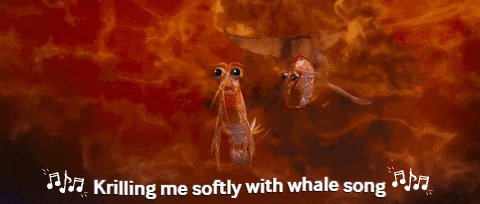
Relationship with humans

Figure 5. Sports Research’s Antarctic Krill Oil with SUPERBA 2 (ph.iherb.com, n.d.)
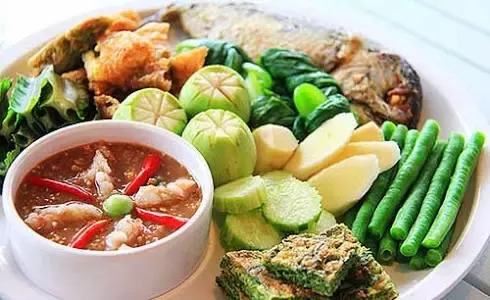
Figure 6. Krill/shrimp chili paste and dipping assortments in Thailand (quora.com, 2016)
Although krill is mainly used as aquaculture feed and bait for fishing, it is also processed into a variety of products for human consumption such as paste, frozen tails, sticks, etc. Krill products have been known to pharmaceutical and industrial industries since it is found that the krill's lipid content can be used as a nutritional source of fatty acids that is potential in lowering cholesterol levels. Studies found that the lipids of Antarctic krill are more stable than those of some fishes consumed by humans. Krill digestive proteases can also be injected into humans to reduce pressure on nerve roots between vertebral discs (Gierak, n.d.). Tou et al. describe Antarctic krill as a “rich source of high-quality protein” with low fat and high levels of Omega-3s and antioxidants and the main source of the renowned krill oil.
5 health benefits of Krill oil you shouldn’t miss!
youtube
Little did you know that..
They are age-defying!
*jaw-dropping moment because olay age-defying serum just cant--*
➔ They have the ability to shrink in size when starve to conserve energy during the winter. Thus, scientists can’t tell the age of a krill solely from its size.

Phytoplankton is just a summer fling!
➔ They can survive more than 200 days without food.
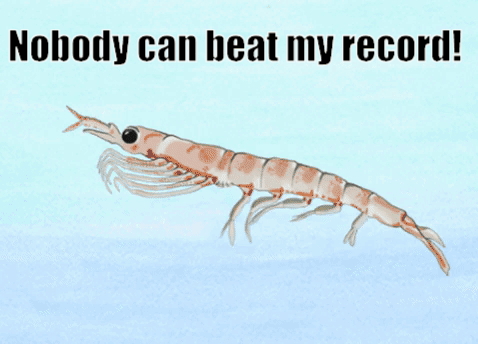
Krillions of krills!
➔ Krill swarm together in massive numbers, with as many as 30,000 in one cubic meter of a krill swarm.
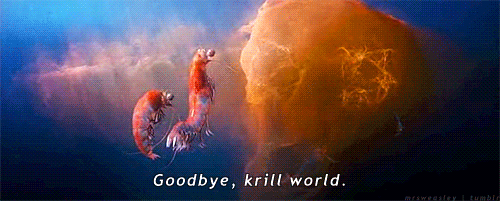
A Little Giant!
➔ It’s estimated that the total weight of Antarctic krill is more than the weight of all humans on Earth (Usoceangov, 2015).

Food is life but swimming is lifer!
➔ They are heavier than seawater and must swim constantly to stay afloat.
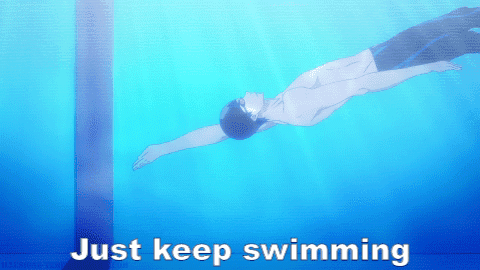
Climate heroes!
➔ Tarling and Thorpe (2017) have discovered that krill play a crucial role in sequestering carbon.
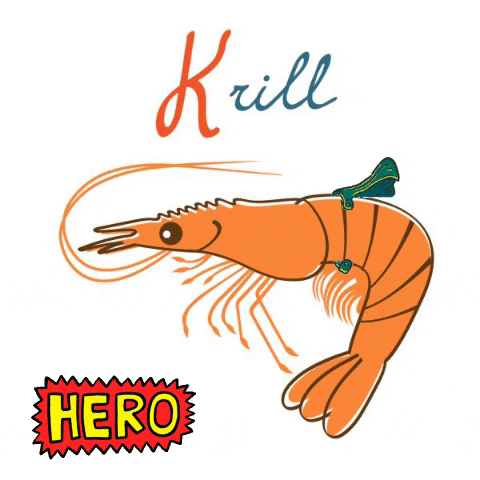
References:
Clark, D. (2012, September 17). The anatomy of the Arctic krill [Digital image]. Retrieved November 12, 2020, from http://1.bp.blogspot.com/-7NY88MHBVpc/UFfn-sAknuI/AAAAAAAAAW4/nkt1_Ba8G8k/s1600/Antarctic_krill_anatomy.jpg
Euphausia superba. (n.d.). ITIS. Retrieved November 8, 2020, from https://www.itis.gov/servlet/SingleRpt/SingleRpt?search_topic=TSN&search_value=95514#null
Euphausia superba (Dana, 1852). (n.d.). FAO. Retrieved November 10, 2020, from http://www.fao.org/fishery/species/3393/en
Exuvia of Antarctic krill [Online image]. (2005). English Wikipedia. https://commons.wikimedia.org/wiki/File:Exuviakrillkils.jpg
Gierak, R. (2013). Euphausia superba (Antarctic krill). Retrieved November 12, 2020, from https://animaldiversity.org/accounts/Euphausia_superba/
Gómez-Gutiérrez, J., & Morales-Ávila, J. R. (2016). Parasites and Diseases. Biology and Ecology of Antarctic Krill, 351–386. https://doi.org/10.1007/978-3-319-29279-3_10
Grzimek's Animal Life Encyclopedia. (2020). Krill: Euphausiacea. Retrieved November 12, 2020, from https://www.encyclopedia.com/science/encyclopedias-almanacs-transcripts-and-maps/krill-euphausiacea
Hardy, R. W. (2008). Alternative marine sources of fish feed and farmed fish quality. Improving Farmed Fish Quality and Safety, 328–342. https://doi.org/10.1533/9781845694920.2.328
Naruturd_505. (n.d.). Hoshiumi Korai A Little Giant GIF [Online GIF]. https://tenor.com/view/hoshiumi-korai-alittle-giant-smile-haikyuu-anime-gif-17909731
Oh, yeah- what?! GIF. (2013). Gfycat. https://gfycat.com/detailedfaintalbertosaurus
SuperSmiles17. (2013). Definitely one in a Krillion! [Online GIF]. https://imgur.com/gallery/YtN30/comment/16282449
Tarling, G.A., and Thorpe, S.E. (2017). Oceanic swarms of Antarctic krill perform satiation sinking. Proc. R. Soc. B., 28420172015. http://doi.org/10.1098/rspb.2017.2015
The Ozone Hole. (n.d.). [Life Cycle of Antarctic Krill]. Retrieved November 12, 2020, from http://www.theozonehole.org/images/v43n2-wiebe3en_10243.jpg
[Untitled image of a tardigrade]. (2017). BBC. https://www.bbc.com/news/science-environment-40752669
Usoceangov. (2015). Animals of the Ice - Antarctic Krill. Youtube. Retrieved November 10, 2020, from https://www.youtube.com/watch?v=RFqhocQqbgM
15 notes
·
View notes
Text
Spooky Old World Fruit Bats!
These cool old world fruit bats are actually kind of mega! They grow up to three pounds and can be up to a foot tall! But their wingspan is the real deal. Their wings can grow up to fifty-nine inches. That’s huge!

The Old World Fruit Bat’s habitat is some regions of Africa, Asia, Australia, the Philippines, a number of islands of the Indian and Pacific Oceans, in Pakistan, and across India. But in habitat specifically they like to live in tropical or sub-tropical areas, where it is very humid.

The evolution of these fruit bats isn’t something that’s well known. More research is needed into these bats to truly understand them. One thing we do know about them though, is that since most bats eat insects and this bat eats fruit, at some point in the history of the first bats, these bats were placed somewhere where there were no insects.

Like I said earlier, these Old World Fruit Bats eat fruit, like it says in their name. They grind the food up into a nectar and eat it. While they can eat in the air it is easier for them to land and eat their food. Some types of these awesome bats called Rousette bats use echolocation to find an accurate way around.

These bats reproduce in groups. Usually one male will live with about eight females in a group called a harem. The females will mate with two or three male bats while the male will mate with as many as possible, but one sub-species of these bats are monogamous. The gestation is between four-six months.
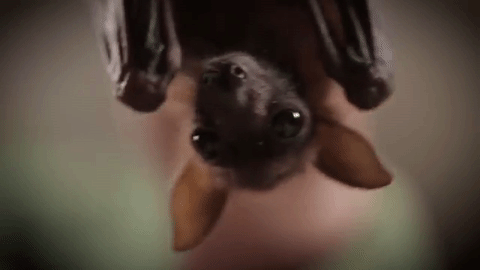
The bats are pretty friendly, and will travel up to thirty miles around to get food or reproduce. They like to sleep hanging upside down.

Kingdom: Animalia
Phylum: Chordata
Class: Mammalia
Order: Chiroptera
Suborder: Megachiroptera ("megabats")
Family: Pteropodidae (42 genera of flying foxes, the Old World fruit bats)
Subfamily: Pteropodinae
Genus: Pteropus (58 species, most are island endemics)

Links!
https://www.britannica.com/animal/Old-World-fruit-bat
http://www.batworlds.com/fruit-bat/
http://cincinnatizoo.org/blog/animals/indian-flying-fox-giant-fruit-bat/
http://www.newworldencyclopedia.org/entry/Megabat
http://www.encyclopedia.com/science/encyclopedias-almanacs-transcripts-and-maps/old-world-fruit-bats-pteropodidae
http://library.sandiegozoo.org/factsheets/rodriques_fruit_bat/rodriques_fruit_bat.html#taxonomy
1 note
·
View note
Text

The guild that is writing the Animalia Almanac has set up a pen pal corespondents to help them gather data and wants YOU to be a part of it!
Ever month a Animalia NPC will send you a letter talking a little bit about themselves and the world around them as well as a handful of stickers from different artists depicting them. Each letter comes with a link to their hidden page on the Animalia Almanac website where you can enjoy reading about their life stories.
check it out as well as weekly updates on my patreon
10 notes
·
View notes
Text

A new subspecies and legend has been once more added to our record. The Madagascariensis Serpentes subspecies has quite a handful of a name leading many to simply call them Malagasy or Mad Hogs. Despite their stern faces and the mad in one of their common names these Serpentes seem to be quite a pleasant subspecies with many of them asking what they could do to help when I was collecting information on them.
Caution is advised against trying to take advantage of anyone under their care as even stating what most would consider to be a ‘rude remark’ about anyone under their care will cause them to become mad and extremely defensive whether or not the remark is truthful in nature. We have yet to get any art depicting their legend or subspecies yet but the log will be updated when we do.
their full Almanac entry can be found here: https://animaliaalmanac.com/Almanac/Lore/Serpentes/Subspecies/Madagascariensis.html
#animalia almanac#Serpentes#snake#hognose snake#madigascar hognose snake#ttrpg#rpg#subspecies sheet#legend
17 notes
·
View notes
Note
For a headcanon, I submit:
The (not so) humble Charidotella sexpunctata, or, Golden Tortoise Beetle
Ah, i love the golden Tortoise beetles, their cool color changing ability is just such a fun adaptation

(https://www.snexplores.org/article/color-changing-bugs)
my 5 second animalia head cannon for these guys is in Animalia they can turn red for a number of reasons, sometimes its stress or in an attempt to blend in with the surroundings, but most turn red when blushing as if their whole body was blushing
if you want me to give you a 5 second animalia head cannon for a species of beetle drop me ask with the beetle!
7 notes
·
View notes
Text
"Who are the historians?"
you ask curiously.
Gray is silent for a moment and you can see her carefully choosing her reply.
"The Historians are in charge of reciting and retelling the story of our subspecies to those that visit Windwall. That are a bit dramatic with it all if you ask me, but their services are what many come to town for. Many of the funds they make from their job go back into the community and help pay for the Guiding Lights supplies." She looks down at her lantern as she continues, "We are grateful for their service to the community." She looks back at you the tone of her voice uninterested. " If you want to know more about them im sure they would love to tell you all about themselves. You can find them by the base of the great wall in the center of town, I think Lumi is on today and should be able to answer any questions you have about the Historians, or the town."
You have unlocked the ability to talk to and find Lumi!

15 notes
·
View notes
Text
Subspecies Just Dropped: Grandis (Great Potoo)
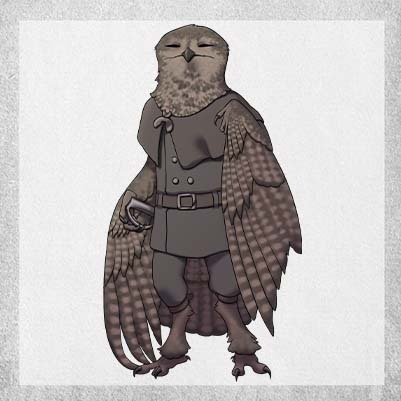
The Grandis are a noble subspecies. They guard their targets with unwavering loyalty and many are willing to put down their lives for those that they have sworn to protect. Because of the this the Grandis are often hired for the more dangerous guard duties such as watching dangerous prisoners or repugnant elites.
Although the Grandis choose what jobs they take, many may find themselves taking up less then ideal jobs due to their wandering nature. Most Grandis do not have a place to call home and will sleep out on the hard ground if they do not currently have a job that pays them or gives them free room and board. This is not because they can't own a house, but rather most follow the traditions of their ancestors and choose to not have things that tie them to one place.

full info on the Grandis subspecies can be found here: https://animaliaalmanac.com/Almanac/Lore/Aves/Subspecies/Grandis.html
Artist for the above artwork: Bundew- https://ko-fi.com/bundew
this is the subspecies for February!
9 notes
·
View notes
Text
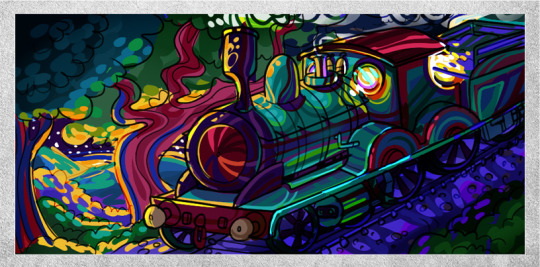
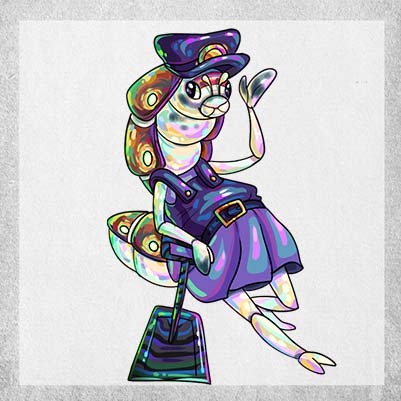
All aboard! Time for the next subspecies sheet to leave the station!
this month's subspecies sheet is the Railway Beetle, a Coloptera species that can glow and in the world of Animalia the Railway Beetle (or Hirtus) often find their homes on train tracks be it part of the crew or as a passenger as long as they are moving along the rails they are happy.
Its thought that the Hirtus's connection to trains dates back to some of the earliest trains with their ancestors being passengers on the mysterious night trian.
to learn more about this subspecies check out the Animalia Almanac website here: https://yeeshastone.com/Almanac/Lore/Coleoptera/Subspecies/Hirtus.html
art drawn by: https://artfight.net/~scissors
9 notes
·
View notes
Text
Creature Art Updated
More research has gone into the Felis Regius Creature and although I am not quite ready to share my written work with everyone, I have received some art of them that is ready to be shared with others. These long creatures seem hard for some artists to capture with their strange body plans, but two individuals I have contacted were up for the task. More art will be needed to fully understand the species, but with every day that passes we learn a little more about how the Felis Regius work.


Art drawn by Voiidless
As well as by Shirokuro Sumi
Felis Regius information can be foundin the Almanac here
4 notes
·
View notes
Text

The Animalia Almanac is in need of your help gathering information to help fill out the Almanac! The Animalia Almanac has reached out to a multitude of Animalian around the world and asked them to share their thoughts with members about where they live, any stories they have been told about their subspecies past and anything about their lives in general. The Guild is now sending out these letters to all members with hope that they can read the text and help the guild fill out our Almanac (a few goodies are often packaged inside as well). If your interested check out the link here: https://www.patreon.com/yeeshastone (second tier) If you like stickers, fun characters and reading lore then this opportunity is for you! more information about the Animalia Almanac project can be found here: https://animaliaalmanac.com/
(image by: https://www.deviantart.com/sprucealmighty)
4 notes
·
View notes
Note
Oh heck yeah beetles! I always remember how beautiful the shine on the Japanese beetles were as a kid, even though my mom hated them for destroying the plants.
ooooh, i haven't heard of these stunning beetles before! They are so beautiful, sucks that they are an invasive pest in the USA :(. We can still appreciate their stunning looks though! These guys 'skeletoniz' plants, meaning they eat the area of the plants between veins leaving just the leaves skeletons behind.
Also as a kind of side note, due to them being a pest in the USA we have a lot of information on their life cycle which is rare. Most beetles are extremely lucky if people know what their eggs or grubs look like, but these guys we have detailed information on every stage of their lives. This kind of research seems reserved for beetles that are either pests or dangerous to humans which makes sense as someone has to pay for the research and those are two of the biggest reasons to learn more about something. Makes me happy though when I get such detailed information on a beetle.

Any way, my 5 second Animalia head cannon for these guys is that they are experts when it comes to making buildings out of plant matter. They will consume vasts amount of a leaf and use the leaves skeleton as a way to hold structures together by tying the remaining veins around things. This can lead to a intricate looking pattern on walls, ceilings and floors that many Animalian love. This style of building is often supported inside by stronger materials leaving the complex pattern as more of a visual design then a structural one. However this way of building a structure can be used on its own for temporary structures such as small huts or lean-to's.
if you want me to give you a 5 second animalia head cannon for a species of beetle drop me ask with the beetle!
4 notes
·
View notes
Text

The Vulpes documentation has been updated. It should now have all of the different subspecies colors and flags. Each flag is now labeled and should connect back to the Vulpes subspecies they are connected to.. I also added the base legend for the Vulpes species, although its looking a bit dry without any art so I will need to find something for it when I get a second. The text has also been adjusted a little to hopefully read a bit better.
full Almanac page can be found here: https://animaliaalmanac.com/Almanac/Lore/Vulpes/Lore/VulpesGroups.html
3 notes
·
View notes
Text

A new subspecies and legend has been added to our records. This Serpentes Subspecies name is Diastema, although it may be known better by its common name, the Variable Coral. As the common name implies this subspecies is part of the Coral family and comes in a number of different striping variations.
The different variation patterns have yet to be recorded but it has been reported that there are seven different patterns. This subspecies also has close connections with a place called ‘The Casino Coral’ as well as being the origin species for Lady Luck. Their page will be updated when more info on these things are collected.
The full Almanac page can be found here: https://animaliaalmanac.com/Almanac/Lore/Serpentes/Subspecies/Diastema.html
6 notes
·
View notes
Text

The Cenchoa have been added as a Serpentes subspecies to the Animalia Almanac as well as their legend.
The Cenchoa are a type of Serpentes with long, thin bodies and large bulbus heads and eyes. Their common name is the fiddle string Serpentes due to the shape of their bodies and their close relation to the instrument. Many Cenchoa study hard to learn how to play the fiddle making them great performers. I managed to listen to a performance while studying them and found myself lost in its eerie, yet soothing sounds. I can only imagine what an orchestra made up of Cenchoa would sound like and perhaps one day I may get the opportunity to be in the audience for one such performance.
Their full sheet can be found in the Almanac here: https://animaliaalmanac.com/Almanac/Lore/Serpentes/Subspecies/Cenchoa.html
art drawn by: https://www.instagram.com/anglerbunny/
4 notes
·
View notes